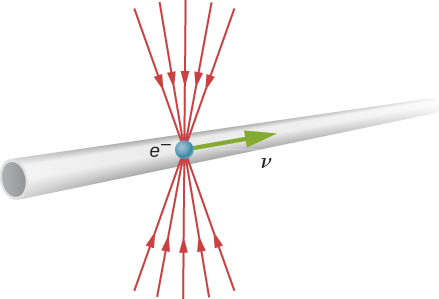| << Chapter < Page | Chapter >> Page > |

Check Your Understanding A particle is traveling through Earth’s atmosphere at a speed of 0.750 c . To an earthbound observer, the distance it travels is 2.50 km. How far does the particle travel as viewed from the particle’s reference frame?
To whom does an object seem greater in length, an observer moving with the object or an observer moving relative to the object? Which observer measures the object’s proper length?
The length of an object is greatest to an observer who is moving with the object, and therefore measures its proper length.
Relativistic effects such as time dilation and length contraction are present for cars and airplanes. Why do these effects seem strange to us?
Suppose an astronaut is moving relative to Earth at a significant fraction of the speed of light. (a) Does he observe the rate of his clocks to have slowed? (b) What change in the rate of earthbound clocks does he see? (c) Does his ship seem to him to shorten? (d) What about the distance between two stars that lie in the direction of his motion? (e) Do he and an earthbound observer agree on his velocity relative to Earth?
a. No, not within the astronaut’s own frame of reference. b. He sees Earth clocks to be in their rest frame moving by him, and therefore sees them slowed. c. No, not within the astronaut’s own frame of reference. d. Yes, he measures the distance between the two stars to be shorter. e. The two observers agree on their relative speed.
A spaceship, 200 m long as seen on board, moves by the Earth at 0.970 c . What is its length as measured by an earthbound observer?
48.6 m
How fast would a 6.0 m-long sports car have to be going past you in order for it to appear only 5.5 m long?
(a) How far does the muon in [link] travel according to the earthbound observer? (b) How far does it travel as viewed by an observer moving with it? Base your calculation on its velocity relative to the Earth and the time it lives (proper time). (c) Verify that these two distances are related through length contraction
Using the values given in [link] : a. 1.39 km; b. 0.433 km; c. 0.433 km
(a) How long would the muon in [link] have lived as observed on Earth if its velocity was (b) How far would it have traveled as observed on Earth? (c) What distance is this in the muon’s frame?
Unreasonable Results A spaceship is heading directly toward Earth at a velocity of 0.800 c . The astronaut on board claims that he can send a canister toward the Earth at 1.20 c relative to Earth. (a) Calculate the velocity the canister must have relative to the spaceship. (b) What is unreasonable about this result? (c) Which assumptions are unreasonable or inconsistent?
a. 10.0 c ; b. The resulting speed of the canister is greater than c, an impossibility. c. It is unreasonable to assume that the canister will move toward the earth at 1.20 c .

Notification Switch
Would you like to follow the 'University physics volume 3' conversation and receive update notifications?